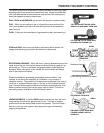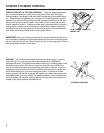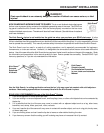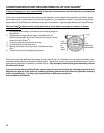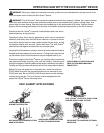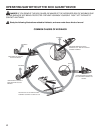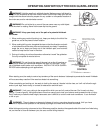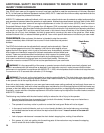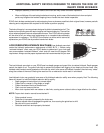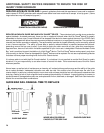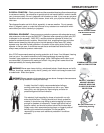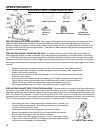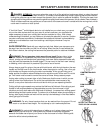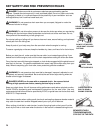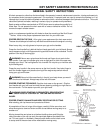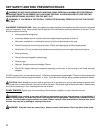
15
• Improper assembly of the chain brake to the chain saw may render the brake inoperable.
• Wear and fatigue of the activating brake band or spring, and/or wear of the brake/clutch drum and pivot
points may lengthen the brake’s stopping time or render the chain brake inoperable.
ECHO chain brakes are designed to retain stopping times as close as possible to their original times, however periodic
cleaning and or adjustment are required for the brake to perform properly.
The brake linkage is in a compartment designed to shield out sawdust and oil. The
brake and surrounding area will require regular and frequent cleaning. There will be
a time when adjustment cannot compensate for wear. Your ECHO servicing dealer
will be able to tell you when parts replacement or a complete brake assembly
replacement is necessary. The ECHO Chain Brake is a device which cannot be
replaced on your ECHO saw by another brand chain brake.
Reduced Kickback Chain
LOW OR REDUCED-KICKBACK SAW CHAIN: Low-kickback saw chain
meets the kickback performance requirements of ANSI B175. 1. Before using
“reduced kickback” chain, see your ECHO dealer to determine if your chain saw
can accommodate “reduced-kickback” chain and still meet the 45-degree CKA
requirement. Always use the proper replacement chain recommended for your saw.
GUARD
LINKS
The low-kickback saw chain on your ECHO saw has depth gauges and guard links to reduce kickback. Depth gauges
control the depth of cut. The guard links help to prevent the cutters from digging in too deeply at the bar nose. Low-
kickback chain tends to resist penetration of the bar tip, which is the cause of kickback; however, the chain may “skate”
along the surface of the wood. Skating the nose bar into an obstruction could result in a kickback.
Low-kickback chain may gradually lose some of its kickback-reduction ability even when properly filed. The following
items will cause it to lose its kickback reduction ability rapidly:
• Depth gauges not set uniformly to correct depth.
• Cutters dull or uneven in filing angle or length.
• Cutters have been filed to a forward hook.
• Chain runs too loose on the bar.
• Worn chain repaired with new cutters or side links, causing some cutters to take a larger bite than the others.
NOTE: Proper chain tension cannot be maintained if:
• Drive sprocket is worn.
• Guide bar is improperly clamped to the chain saw.
• Tension adjuster has not engaged the guide bar, thus causing the guide-bar to shift.
• Bar rails are in poor condition.
• Guide bar and chain are improperly lubricated.
ADDITIONAL SAFETY DEVICES DESIGNED TO REDUCE THE RISK OF
INJURY FROM KICKBACK



